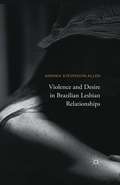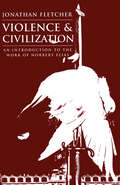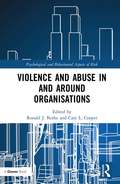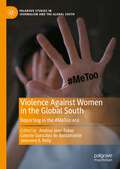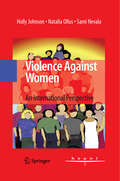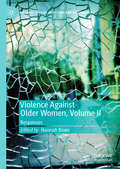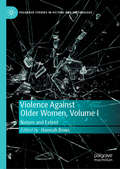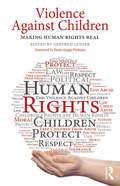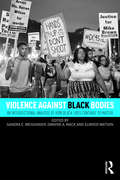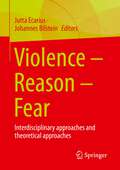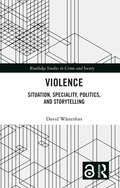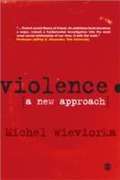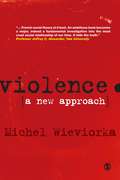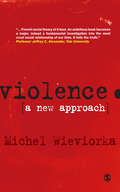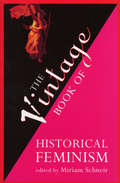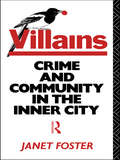- Table View
- List View
Violence and Desire in Brazilian Lesbian Relationships
by Andrea Stevenson AllenIn Violence and Desire in Brazilian Lesbian Relationships, Allen examines the lives of Brazilian women in same-sex relationships. This examination contributes to interdisciplinary discussions of female same-sex sexuality, violence, race, and citizenship. Using fifteen months of ethnographic fieldwork, primarily with Afro-Brazilian women in the city of Salvador da Bahia, Allen argues that Brazilian lesbian women reject Brazilian cultural norms that encourage male domination and female submission through their engagement in romantic relationships with each other. At the same time Allen claims lesbian women also reproduce Brazilian cultural ideals that associate passion, intensity, and power with physical dominance through their engagement in infidelity and intimate partner violence. The book demonstrates that lesbian women are nonetheless marginalized as Brazilian citizens through widespread social and political invisibility despite these apparent displays of masculinized power.
Violence and Civilization: An Introduction to the Work of Norbert Elias
by Jonathan FletcherThis book provides an introduction to the work of Norbert Elias. It is the first systematic appraisal of two central themes of his thought - violence and civilization. Although Elias is best known for his theory of civilizing processes, this study highlights the crucial importance of the concept of decivilizing processes. Fletcher argues that while Elias did not develop a theory of decivilizing processes, such a theory is logically implied in his perspective and is highly pertinent to an understanding of the most violent episodes of twentieth-century history, such as the Nazi genocides. Elias's original synthesis of sociology and psychology is examined through an analysis of several key texts including The Civilizing Process, The Established and the Outsiders and The Germans. Fletcher shows how Elias constructs his "figurational models" and applies these comparatively to specific historical examples drawn from England and Germany. Violence and Civilization is an excellent introduction to Elias's work. It will appeal to students of sociology, anthropology, and history interested in understanding the phenomenon of violence in the modern world.
Violence and Civilization: An Introduction to the Work of Norbert Elias
by Jonathan FletcherThis book provides an introduction to the work of Norbert Elias. It is the first systematic appraisal of two central themes of his thought - violence and civilization. Although Elias is best known for his theory of civilizing processes, this study highlights the crucial importance of the concept of decivilizing processes. Fletcher argues that while Elias did not develop a theory of decivilizing processes, such a theory is logically implied in his perspective and is highly pertinent to an understanding of the most violent episodes of twentieth-century history, such as the Nazi genocides. Elias's original synthesis of sociology and psychology is examined through an analysis of several key texts including The Civilizing Process, The Established and the Outsiders and The Germans. Fletcher shows how Elias constructs his "figurational models" and applies these comparatively to specific historical examples drawn from England and Germany. Violence and Civilization is an excellent introduction to Elias's work. It will appeal to students of sociology, anthropology, and history interested in understanding the phenomenon of violence in the modern world.
Violence and Abuse In and Around Organisations (Psychological and Behavioural Aspects of Risk)
by Ronald J. Burke Cary L. CooperThis international collection examines violence and abuse in and around organisations. The collection documents the causes, specifically from the perspective of human relations and of the workplace conditions. It also highlights the specific risks associated with high-risk professions or working environments. The first section considers types of violence and abuse, their relative frequencies, potential individual and workplace antecedents, costs to individuals, family’s organisations and societies, the fact both are increasing in frequency with new types (e.g., terrorism) appearing, and why addressing these has become increasingly important for individuals and organisations. The second section considers violence in interpersonal relationships such as bullying, incivility, bias and harassment, and toxic leadership. The third section examines unsafe workplaces, accidents, injuries, and deaths. The fourth section considers exploitive work conditions and arrangements such as precarious employment, the exploitation of immigrants, and human slavery. The final section offers suggestions on ways to address violence and abuse in and around organisations. These include aggression preventative supervisor behaviours in health care, suicide prevention in the workplace, dealing with disgruntled employees and former employees, and workplace interventions that address stress reduction more broadly. As with other titles in the Psychological and Behavioural Aspects of Risk Series, this research-based collection is firmly grounded in the boundary between work and society and offers important insights into how social and cultural problems are manifest in the workplace and how poor and abusive workplace practice, in turn, spills out into wider life.
Violence and Abuse In and Around Organisations (Psychological and Behavioural Aspects of Risk)
by Ronald J. Burke Cary L. CooperThis international collection examines violence and abuse in and around organisations. The collection documents the causes, specifically from the perspective of human relations and of the workplace conditions. It also highlights the specific risks associated with high-risk professions or working environments. The first section considers types of violence and abuse, their relative frequencies, potential individual and workplace antecedents, costs to individuals, family’s organisations and societies, the fact both are increasing in frequency with new types (e.g., terrorism) appearing, and why addressing these has become increasingly important for individuals and organisations. The second section considers violence in interpersonal relationships such as bullying, incivility, bias and harassment, and toxic leadership. The third section examines unsafe workplaces, accidents, injuries, and deaths. The fourth section considers exploitive work conditions and arrangements such as precarious employment, the exploitation of immigrants, and human slavery. The final section offers suggestions on ways to address violence and abuse in and around organisations. These include aggression preventative supervisor behaviours in health care, suicide prevention in the workplace, dealing with disgruntled employees and former employees, and workplace interventions that address stress reduction more broadly. As with other titles in the Psychological and Behavioural Aspects of Risk Series, this research-based collection is firmly grounded in the boundary between work and society and offers important insights into how social and cultural problems are manifest in the workplace and how poor and abusive workplace practice, in turn, spills out into wider life.
Violence Against Women in the Global South: Reporting in the #MeToo era (Palgrave Studies in Journalism and the Global South)
by Andrea Jean Baker Celeste González de Bustamante Jeannine E. RellyBringing together 14 journalism scholars from around the world, this edited collection addresses the deficit of coverage of violence against women in the Global South by examining the role of the legacy press and social media that report on and highlight ways to improve reporting. Authors investigate the ontological limitations which present structural and systemic challenges for journalists who report on the normalization of violence against women in country cases in Argentina; Brazil; Mexico; Indonesia; Kenya, Nigeria, South Africa; Egypt; Libya, Syria, and Yemen. Challenges include patriarchal forces; gender imbalance in newsrooms; propaganda and censorship strategies by repressive, hyper-masculine, and populist political regimes; economic and digital inequities; and civil and transnational wars. Presenting diverse conceptual, methodological, and empirical chapters, the collection offers a revision of existing frameworks and guidelines and aims to promote more gender-sensitive, trauma-informed, solutions-driven, and victim or survivor centered reporting in the region.
Violence Against Women: An International Perspective
by Holly Johnson Natalia Ollus Sami NevalaThis is an international, comparative survey which interviews random samples of women about their experiences with male violence. The authors form a management team for the International Violence Against Women Survey (IVAWS). The primary objective of IVAWS is to investigate the level and nature of victimization of women in a number of countries worldwide This work builds on the international network and experience of the European Institute of Crime Prevention and Control (HUENI).
Violence Against Older Women, Volume II: Responses (Palgrave Studies in Victims and Victimology)
by Hannah BowsThis book brings together international research from scholars and activists on the forms of violence that older women experience into a unique, comprehensive two-volume set. This volume is concerned with understanding the consequences and impacts of violence against older women. The majority of policy and practice has been developed to reflect the dynamics and contexts of violence affecting young women, and most of the available support services had focused on the needs of those of child-bearing age. This volume sheds light on the specific needs and effectiveness of responses to violence against older women, and identifies both challenges and opportunities for developing services that meet older survivor's needs. It will be of interest to researchers in social and health care, gerontology, sociology and social policy, feminist research and criminology.
Violence Against Older Women, Volume I: Nature and Extent (Palgrave Studies in Victims and Victimology)
by Hannah BowsThis book brings together international research from scholars and activists on the forms of violence that older women experience into a unique, comprehensive two-volume set. This first volume consolidates the research on the forms, causes and extent of different forms of violence against older women. It considers the theoretical limitations of our understandings and charts the gaps in empirical and theoretical research in this area and how this has hindered effective policy and practice responses to violence against older women. Taken together, this volume offers an important starting point from which future research can draw to address the gaps in knowledge and evidence. It also highlights issues that are particular to older women’s experiences of violence compared with younger women. It highlights gaps in existing research and suggests a future research agenda and implications for practitioners. It will be of interest to researchers in social and health care, gerontology, sociology and social policy, feminist research and criminology.
Violence Against Children: Making Human Rights Real
by Gertrud LenzerViolence Against Children adopts in its title the exhortation of Nobel Laureate Amartya Sen, "Making Human Rights Real," which also represents the leitmotif of the book. It examines the prevalence of violence against children in Africa, the Asia Pacific Region, Europe, Latin America and the Caribbean, and in the United States, and explores major ways of its prevention. Making human rights real engenders the challenge of helping all children to be free from violence and to lead a life replete with genuine nurture and the elimination of all violence. Only in this manner will the goal of the United Nations 2030 Agenda for Sustainable Development —target 16.2—be achieved and the child as a rights-bearing individual realized in her/his fullness. The specially commissioned chapters that make up the volume have been written by renowned scholars, researchers and advocates. They coalesce to provide an overview of the challenges facing children exposed to violence worldwide, and they advance discussions of the measures which are available and necessary for the prevention of violence against children. The book is intended for policy-makers, researchers and students of the social sciences and human rights who are interested in ending all the widespread maltreatment of children in our societies and our time.
Violence Against Children: Making Human Rights Real
by Gertrud Lenzer Paulo Sérgio PinheiroViolence Against Children adopts in its title the exhortation of Nobel Laureate Amartya Sen, "Making Human Rights Real," which also represents the leitmotif of the book. It examines the prevalence of violence against children in Africa, the Asia Pacific Region, Europe, Latin America and the Caribbean, and in the United States, and explores major ways of its prevention. Making human rights real engenders the challenge of helping all children to be free from violence and to lead a life replete with genuine nurture and the elimination of all violence. Only in this manner will the goal of the United Nations 2030 Agenda for Sustainable Development —target 16.2—be achieved and the child as a rights-bearing individual realized in her/his fullness. The specially commissioned chapters that make up the volume have been written by renowned scholars, researchers and advocates. They coalesce to provide an overview of the challenges facing children exposed to violence worldwide, and they advance discussions of the measures which are available and necessary for the prevention of violence against children. The book is intended for policy-makers, researchers and students of the social sciences and human rights who are interested in ending all the widespread maltreatment of children in our societies and our time.
Violence Against Black Bodies: An Intersectional Analysis of How Black Lives Continue to Matter
by Sandra E. Weissinger Dwayne A. Mack Elwood WatsonViolence Against Black Bodies argues that black deaths at the hands of police are just one form of violence that black and brown people face daily in the western world. Through the voices of scholars from different academic disciplines, this book gives readers an opportunity to put the cases together and see that violent deaths in police custody are just one tentacle of the racial order—a hierarchy which is designed to produce trauma and discrimination according to one’s perceived race and ethnicity.
Violence Against Black Bodies: An Intersectional Analysis of How Black Lives Continue to Matter
by Sandra E. Weissinger Dwayne A. Mack Elwood WatsonViolence Against Black Bodies argues that black deaths at the hands of police are just one form of violence that black and brown people face daily in the western world. Through the voices of scholars from different academic disciplines, this book gives readers an opportunity to put the cases together and see that violent deaths in police custody are just one tentacle of the racial order—a hierarchy which is designed to produce trauma and discrimination according to one’s perceived race and ethnicity.
Violence – Reason – Fear: Interdisciplinary approaches and theoretical approaches
by Jutta Ecarius Johannes BilsteinThe book explores the question of the significance of fear and reason in the context of cultural violence and subjective different experiences of violence. Perspectives from the social sciences, educational philosophy and cultural studies open up an interdisciplinary approach to violence of culture and media, the experience of fear and vulnerability as well as strangeness and rage.
Violence: Situation, Speciality, Politics and Storytelling (Routledge Studies in Crime and Society)
by David WästerforsThis book considers how the concept of violence has been interpreted, used, defined, and explored by social researchers and thinkers. It does not provide a final answer to the question of what violence is or how it should be explained (or prevented), and instead offers a variety of useful ways of thinking about and theorising the phenomenon, mainly from a sociological standpoint. It outlines four ways of understanding violence: • Violence as situation: the tension that exists between category-driven and situational explanations. • Violence as speciality: the study of particularly violent actors, and how they may be understood by reference to childhood histories, technologies, institutions, culture, class, and gender. • Violence as politics: political violence and violent politics. • Violence as storytelling: representations of violence from a narrative perspective. Concluding with reflections on possible convergences between the four approaches and new directions for research, this book offers a unique and experimental approach to discussing and reconstructing the concept of violence. It is essential reading for criminologists, sociologists, and philosophers alike.
Violence: Situation, Speciality, Politics and Storytelling (Routledge Studies in Crime and Society)
by David WästerforsThis book considers how the concept of violence has been interpreted, used, defined, and explored by social researchers and thinkers. It does not provide a final answer to the question of what violence is or how it should be explained (or prevented), and instead offers a variety of useful ways of thinking about and theorising the phenomenon, mainly from a sociological standpoint. It outlines four ways of understanding violence: • Violence as situation: the tension that exists between category-driven and situational explanations. • Violence as speciality: the study of particularly violent actors, and how they may be understood by reference to childhood histories, technologies, institutions, culture, class, and gender. • Violence as politics: political violence and violent politics. • Violence as storytelling: representations of violence from a narrative perspective. Concluding with reflections on possible convergences between the four approaches and new directions for research, this book offers a unique and experimental approach to discussing and reconstructing the concept of violence. It is essential reading for criminologists, sociologists, and philosophers alike.
Violence: A New Approach (PDF)
by Michel WieviorkaViolence is an ever-present phenomenon - obstinately resistant to interpretation. This text offers new tools to understand and analyze violence, presenting a new approach based on the subjectivity of the actor, and on the relation between violence and meaning.
Violence: A New Approach
by Michel Wieviorka"Violence is sadly central to social life and yet oddly marginal to social theory. It's there in the background, not least as Weber defines the state by its monopoly of legitimate violence. But as the example suggests, it's the control of violence that looms large. Michel Wieviorka does a considerable service by calling our attention to violence itself, and to the theories like those of Sorel and Fanon who took it seriously. Wieviorka addresses the state, the media, and social movements. But perhaps his most important contributions come in examination of the ways in which violence informs and is informed by different dimensions of subjectivity. Thoughtfully intertwining classical theory and contemporary observation this is an engaging book, and one that should spark much new thought and research. " - Craig Calhoun, London School of Economics and Political Science Violence is an ever-present phenomenon - obstinately resistant to interpretation. This text offers new tools to understand and analyze violence, presenting a new approach based on the subjectivity of the actor, and on the relation between violence and meaning. The first section discusses violence and conflict, violence and the state, and violence and the media. This provides critical context for developing a new paradigm - in the second section - that gives more importance to the concept of the subject than more classical paradigms. The text distinguishes different possible relations between the meaning of action and violence and proposes a new typology of the subjects involved in violence. It gives particular emphasis to discussing cruelty, violence for violence sake, and 'pure' violence. The relationship between conflict and violence; the place of victims, and the role of the media all shape new forms of violence. This text is an engaged response to these new forms that presents a convincing interpretation and new tools that will be essential for researchers in the social sciences.
Violence: A New Approach (PDF)
by Prof Michel Wieviorka"Violence is sadly central to social life and yet oddly marginal to social theory. It’s there in the background, not least as Weber defines the state by its monopoly of legitimate violence. But as the example suggests, it’s the control of violence that looms large. Michel Wieviorka does a considerable service by calling our attention to violence itself, and to the theories like those of Sorel and Fanon who took it seriously. Wieviorka addresses the state, the media, and social movements. But perhaps his most important contributions come in examination of the ways in which violence informs and is informed by different dimensions of subjectivity. Thoughtfully intertwining classical theory and contemporary observation this is an engaging book, and one that should spark much new thought and research." - Craig Calhoun, London School of Economics and Political Science Violence is an ever-present phenomenon - obstinately resistant to interpretation. This text offers new tools to understand and analyze violence, presenting a new approach based on the subjectivity of the actor, and on the relation between violence and meaning. The first section discusses violence and conflict, violence and the state, and violence and the media. This provides critical context for developing a new paradigm - in the second section - that gives more importance to the concept of the subject than more classical paradigms. The text distinguishes different possible relations between the meaning of action and violence and proposes a new typology of the subjects involved in violence. It gives particular emphasis to discussing cruelty, violence for violence sake, and 'pure' violence. The relationship between conflict and violence; the place of victims, and the role of the media all shape new forms of violence. This text is an engaged response to these new forms that presents a convincing interpretation and new tools that will be essential for researchers in the social sciences.
Violence: A New Approach
by Prof Michel Wieviorka"Violence is sadly central to social life and yet oddly marginal to social theory. It’s there in the background, not least as Weber defines the state by its monopoly of legitimate violence. But as the example suggests, it’s the control of violence that looms large. Michel Wieviorka does a considerable service by calling our attention to violence itself, and to the theories like those of Sorel and Fanon who took it seriously. Wieviorka addresses the state, the media, and social movements. But perhaps his most important contributions come in examination of the ways in which violence informs and is informed by different dimensions of subjectivity. Thoughtfully intertwining classical theory and contemporary observation this is an engaging book, and one that should spark much new thought and research." - Craig Calhoun, London School of Economics and Political Science Violence is an ever-present phenomenon - obstinately resistant to interpretation. This text offers new tools to understand and analyze violence, presenting a new approach based on the subjectivity of the actor, and on the relation between violence and meaning. The first section discusses violence and conflict, violence and the state, and violence and the media. This provides critical context for developing a new paradigm - in the second section - that gives more importance to the concept of the subject than more classical paradigms. The text distinguishes different possible relations between the meaning of action and violence and proposes a new typology of the subjects involved in violence. It gives particular emphasis to discussing cruelty, violence for violence sake, and 'pure' violence. The relationship between conflict and violence; the place of victims, and the role of the media all shape new forms of violence. This text is an engaged response to these new forms that presents a convincing interpretation and new tools that will be essential for researchers in the social sciences.
Vinyl: The Analogue Record in the Digital Age
by Dominik Bartmanski Ian WoodwardRecent years have seen not just a revival, but a rebirth of the analogue record. More than merely a nostalgic craze, vinyl has become a cultural icon. As music consumption migrated to digital and online, this seemingly obsolete medium became the fastest-growing format in music sales. Whilst vinyl never ceased to be the favorite amongst many music lovers and DJs, from the late 1980s the recording industry regarded it as an outdated relic, consigned to dusty domestic corners and obscure record shops. So why is vinyl now experiencing a ‘rebirth of its cool’?Dominik Bartmanski and Ian Woodward explore this question by combining a cultural sociological approach with insights from material culture studies. Presenting vinyl as a multifaceted cultural object, they investigate the reasons behind its persistence within our technologically accelerated culture. Informed by media analysis, urban ethnography and the authors’ interviews with musicians, DJs, sound engineers, record store owners, collectors and cutting-edge label chiefs from a range of metropolitan centres renowned for thriving music scenes including London, New York, Tokyo, Melbourne, and especially Berlin, what emerges is a story of a modern icon.
Vinyl: The Analogue Record in the Digital Age
by Dominik Bartmanski Ian WoodwardRecent years have seen not just a revival, but a rebirth of the analogue record. More than merely a nostalgic craze, vinyl has become a cultural icon. As music consumption migrated to digital and online, this seemingly obsolete medium became the fastest-growing format in music sales. Whilst vinyl never ceased to be the favorite amongst many music lovers and DJs, from the late 1980s the recording industry regarded it as an outdated relic, consigned to dusty domestic corners and obscure record shops. So why is vinyl now experiencing a ‘rebirth of its cool’?Dominik Bartmanski and Ian Woodward explore this question by combining a cultural sociological approach with insights from material culture studies. Presenting vinyl as a multifaceted cultural object, they investigate the reasons behind its persistence within our technologically accelerated culture. Informed by media analysis, urban ethnography and the authors’ interviews with musicians, DJs, sound engineers, record store owners, collectors and cutting-edge label chiefs from a range of metropolitan centres renowned for thriving music scenes including London, New York, Tokyo, Melbourne, and especially Berlin, what emerges is a story of a modern icon.
The Vintage Book Of Historical Feminism
by Miriam SchneirHere are the essential historical writings of feminism. Many of the works, long out of print or forgotten in what Miriam Schneir describes as a male-dominated literary tradition, are finally brought out of obscurity and into the light of contemporary analysis and criticism. Included are more than forty selections, covering 150 years of writing on women's struggle for freedom - from Mary Wollstonecraft and George Sand to Emma Goldman and Clara Zetkiln.
Villains - Foster
by Janet Foster"Villians" provides a rare insight into local and family traditions of petty crime. It looks at attitudes to crime and law enforcement, and the relationship of those attitudes to the culture in which they are expressed. This book should be of interest to students and teachers in police studies, ethnomethodology and women's studies.
Villains - Foster
by Janet Foster"Villians" provides a rare insight into local and family traditions of petty crime. It looks at attitudes to crime and law enforcement, and the relationship of those attitudes to the culture in which they are expressed. This book should be of interest to students and teachers in police studies, ethnomethodology and women's studies.
